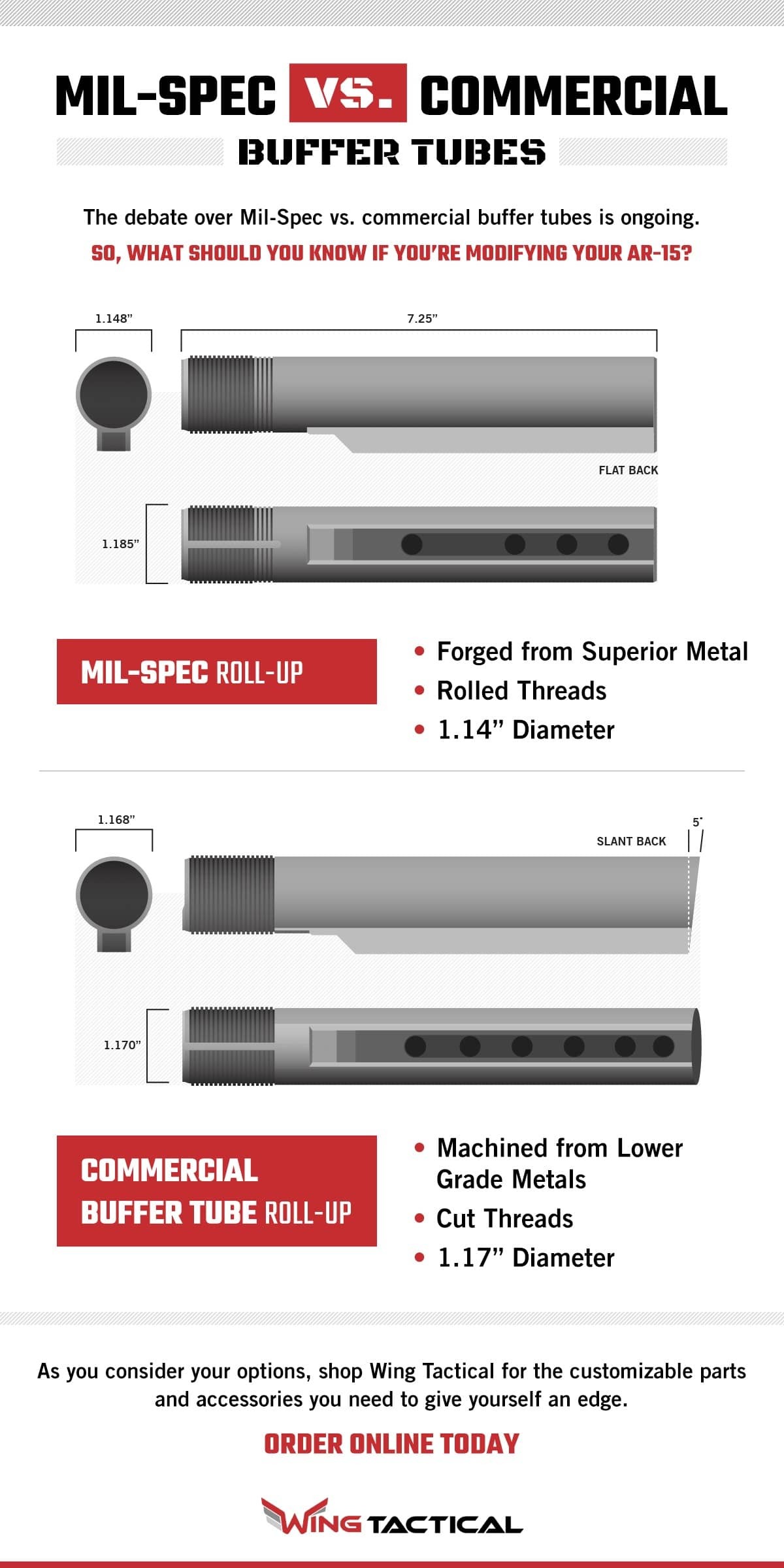
The debate over the difference between Mil-Spec and commercial AR-15 buffer tubes (officially referred to as the receiver extension) has been raging for decades. While they both accomplish the exact same function, there are very real differences between the two. Anyone who is upgrading their AR-15 stock or planning a custom AR build needs to understand these differences to make an informed decision.
Mil-Spec vs. Commercial Buffer Tubes
At first glance, the Mil-Spec and commercial buffer tubes look almost identical. However, the diameter of the buffer tube needs to be measured to determine whether it is Mil-Spec or commercial.
When comparing the commercial vs. Mil-Spec buffer tubes, the Mil-Spec buffer tube will have a diameter of 1.14” while the commercial buffer tube will measure 1.17”. Even though there is only a small .03” difference between the two, this change has major implications regarding compatibility.
Another way to visually see if the receiver extension is commercial-spec or Mil-Spec is to look at the back of the buffer tube. Many of the commercial buffer tubes will have about a 5-degree slant to the back, while Mil-Spec will have a straight 90-degree flat back.
The specific differences between the commercial vs. Mil-spec buffer tubes will be discussed next.

What is a Mil-Spec Buffer Tube?
More expensive to produce and made with superior metal, Mil-Spec receiver extensions are forged from a single piece of 7075-T6 alloy aluminum. Because it is forged, the threads are rolled and created through a process of forcing or extruding the threads out. Rolled threads are superior to cut threads because they have more strength and durability.
A major difference between Mil-Spec and commercial buffer tubes is that Mil-Spec buffer tubes are considered standard in the industry. Most retailers, gunsmiths, and gun manufacturers make their parts and accessories to Mil-Spec standards because it makes them easier to sell to law enforcement and military agencies who almost always use Mil-Spec for their weapons. This is one of the reasons that when it comes to commercial vs. Mil-Spec buffer tubes, the Mil-spec are more compatible across the spectrum of upgrades and options that are available.
Mil-Spec roll-up:
- More expensive
- Higher Quality
- Forged from Superior Metal
- Greater Compatibility
- Rolled Threads
- 1.14” Diameter
What is a Commercial Buffer Tube
One main difference between commercial and Mil-Spec buffer tubes is that commercial buffer tubes are created and designed to be less expensive. This is accomplished by using lower-grade aluminum, usually 6061. Unlike Mil-Spec, which is forged out of a single piece of aluminum, commercial receiver extensions are usually machined and made from multiple pieces of metal.
The threads on commercial vs. Mil-Spec buffer tubes are not rolled like Mil-Spec, instead, they are cut. This results in weaker threads because the cutting process will leave behind tiny tears, especially in the valley portion of the threads. With extended use, the metal will expand and can result in cracks over time. Mil-Spec threads are generally accepted to be more durable because the forged roll threading process does not leave behind these tears.
Ultimately, when comparing commercial vs. Mil-spec buffer tubes, they do not have the same level of compatibility, mainly because of the .03 difference in diameter. This means that many accessories that are designed for Mil-Spec will not work with commercial buffer tubes.
Commercial Buffer Tube Roll-Up:
- Less Expensive
- Lower Quality
- Machined from Lower Grade Metals
- Less Compatibility
- Cut Threads
- 1.17” Diameter
- Common Questions
To make an informed decision about whether commercial vs. Mil-Spec buffer tubes are the right choice, four main questions always need to be answered. Below are four of the most common questions:
FAQs
Q: Which is More Common?
A: One noticeable difference between Mil-Spec and commercial buffer tubes is that Mil-Spec is used much more frequently than commercial. The main reason for this is that most retailers and manufacturers want law enforcement and Department of Defense agencies, who generally use Mil-Spec, to purchase their products. This results in many more upgrades and accessories that are designed to fit Mil-Spec, making it a more compatible choice.
Q: Can a Commercial Tube Work with a Mil-Spec Buttstock?
A: No, a buttstock designed for a Mil-Spec buffer tube should never be forced onto the larger diameter commercial buffer tube. If it is forced onto the commercial tube, a jam may result, and it will likely damage one or both components. Therefore, it is very important to know whether a Mil-Spec vs. commercial buffer tube is on the AR-15 before purchasing a new buttstock.
Q: Can a Mil-Spec Tube Work with a Commercial Buttstock?
A: Yes, however, this comes with some caveats. The commercial-spec is .03” larger than the Mil-Spec, meaning that a commercial stock can be attached to a Mil-Spec buffer, however, it will not be a tight fit. For this reason, it is always recommended to match commercial buffer tubes with commercial buttstocks.
Q: Can Mil-Spec and Commercial Tubes Use The Same Inner Parts (BCG, Buffer, and Spring)?
A: Yes. The bolt carrier group, recoil buffer, and action spring will all work with both Mil-Spec and commercial buffer tubes.
Related Resources: